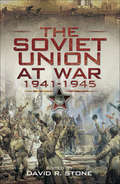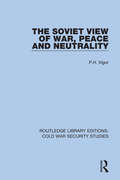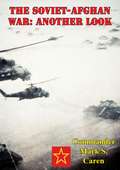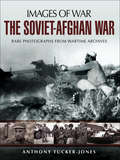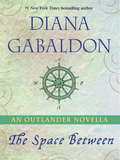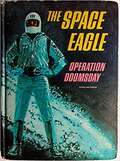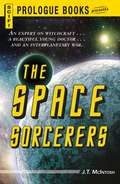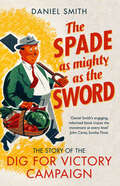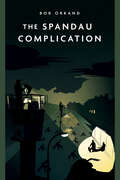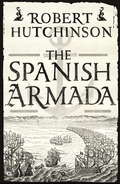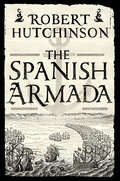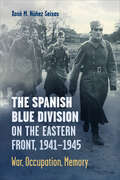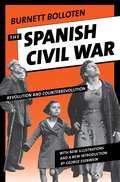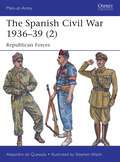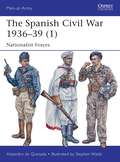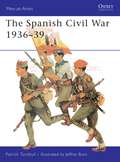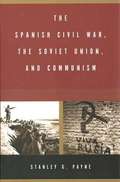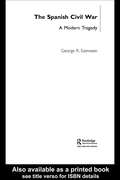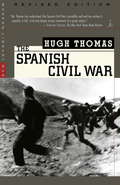- Table View
- List View
The Soviet Union at War, 1941–1945
by David R. StoneHitlers invasion of the Soviet Union in 1941 precipitated a massive clash of arms that gave rise to destruction and suffering on an unprecedented scale. The outcome of this ruthless struggle on the Eastern Front was decisive for the course of the war in Europe. Yet the campaigns fought there still receive less attention than those fought by the Western Allies, and are less well understood. That is why this new survey of the Soviet Union during the Second World War, edited by David R. Stone, is so timely and significant.Stone has brought together a distinguished group of experts who give a penetrating reassessment of the Soviet war effort and economy. They offer a telling insight into the way in which enormous obstacles were overcome and sacrifices were made in order to achieve an overwhelming victory that changed the shape of Europe. Their wide-ranging analysis seeks to dispel myths and misperceptions that have distorted our understanding of the performance of the Red Army and the Soviet people.Editor David R. Stone is professor of history at Kansas State University. He is a leading authority on the military and political history of the Soviet Union in the 1920s and 1930s. As well as writing numerous journal articles, he is the author of two major studies: A Military History of Russia: From Ivan the Terrible to the War in Chechnya and Hammer and Rifle: The Militarization of the Soviet Union 1926–1933.
The Soviet Union’s Agricultural Biowarfare Programme: Ploughshares to Swords
by Anthony RimmingtonThis book focuses upon the secret agricultural biological warfare programme codenamed Ekologiya – which was pursued by the Soviet Union from 1958 through to the collapse of the USSR in 1991. It was the largest offensive agricultural biowarfare project the world has ever seen and Soviet anti-crop and anti-livestock weapons had the capability to inflict enormous damage on Western agriculture. Beginning in the early 1970s, there was a new focus within the Soviet agricultural biowarfare programme on molecular biology and the development of genetically modified agents. A key characteristic of the Ekologiya project was the creation of mobilization production facilities. These ostensibly civil manufacturing plants incorporated capacity for production of biowarfare agents in wartime emergency. During the 1990s-2000s, the counter-proliferation efforts undertaken by the US and UK played a major role in preventing the transfer of Ekologiya scientists, technologies and pathogens to Iran and other countries of potential proliferation concern.Anthony Rimmington is a former Senior Research Fellow at Birmingham University’s Centre for Russian, European and Eurasian Studies, UK. He has published widely on the civil life sciences sector in the post-Soviet states and on the Soviet Union’s offensive biological warfare programme, including Stalin’s Secret Weapon: The Origins of Soviet Biological Warfare.
The Soviet Union’s Invisible Weapons of Mass Destruction: Biopreparat's Covert Biological Warfare Programme
by Anthony RimmingtonThis book focuses on Biopreparat, the Soviet agency created in 1974, which spearheaded the largest and most sophisticated biological warfare programme the world has ever seen. At its height, Biopreparat employed more than 30,000 personnel and incorporated an enormous network embracing military-focused research institutes, design centres, biowarfare pilot facilities and dual-use production plants. The secret network pursued major offensive R&D programmes, which sought to use genetic engineering techniques to create microbial strains resistant to antibiotics and with wholly new and unexpected pathogenic properties. During the mid-1980s, Biopreparat increased in size and political importance and also emerged as a major civil biopharmaceutical player in the USSR. In the wake of the collapse of the Soviet Union in 1991, an acute struggle for control of Biopreparat’s most valuable assets took place and the network was eventually broken-up and control of its facilities transferred to a myriad of state agencies and private companies.
The Soviet View of War, Peace and Neutrality (Routledge Library Editions: Cold War Security Studies #57)
by P.H. VigorThis book, first published in 1975, analyses the three tools which the Russians used for attaining their political objectives: war, peace and neutrality. This study shows how they have evolved a clear-cut view, based on Marxism-Leninism, of the origins of war, the categories of war, the ways in which it can be made to serve the Marxist revolutionary interest, and the circumstances in which it is profitable to use it. As for peace, both Lenin and Khrushchev described it as a ‘temporary, unstable armistice between two wars’. In the Leninist view, peace is a tool for attaining political objectives just like war, while neutrality is essentially ridiculous: ‘he who is not with me is against me’. Nevertheless, there are occasions when neutrality is a concept acceptable to the Soviet leaders, and this study examines instances of this, alongside war and peace.
The Soviet-Afghan War: Another Look
by Commander Mark S. CarenThis research effort reviews the Soviet military's involvement in Afghanistan from four general, perspectives: (1) systemic problems inherent in the Soviet military culture, (2) the use of surprise, (3) operational maneuver and the preeminence of aviation and (4) employment of mines and chemical weapons as an extension of maneuver warfare. This paper concludes that the lessons of this war have been learned by the Russians. There is every reason to believe that they can achieve the level of doctrinal changes required to be successful in future "local" interventions. It must be accompanied, however, by corresponding socio-military reform.
The Soviet-Afghan War: Rare Photographs from Wartime Archives (Images of War)
by Anthony Tucker-JonesThis photographic history of the Soviet-Afghan War of 1979 to 1989 gives a fascinating insight into a grim conflict that prefigured the American-led campaign in that country. In an unequal struggle, the mujahedeen resisted for ten years, then triumphed over Moscow. For the Soviet Union, the futile intervention has been compared to the similar humiliation suffered by the United States in Vietnam. For the Afghans the victory was just one episode in the long history of their efforts to free their territory from the interference of foreign powers. By focusing on the Soviet use of heavy weaponry, Anthony Tucker-Jones shows the imbalance at the heart of a conflict in which the mechanized, industrial might of a super power was set against lightly armed partisans who became experts in infiltration tactics and ambushes. His work is a visual record of the tactics and the equipment the Soviets used to counter the resistance and protect vulnerable convoys.It also shows what this grueling conflict was like for the Soviet soldiers, the guerrilla fighters and the Afghan population, and it puts the present war in Afghanistan in a thought-provoking historical perspective.
The Space Between: An Outlander Novella (Outlander)
by Diana GabaldonNEW YORK TIMES BESTSELLERDiana Gabaldon returns to her Outlander universe in "The Space Between," an irresistible novella brimming with adventure, history, and suspense--and available for the first time as a standalone eBook. Features a preview of the much-anticipated new Outlander novel, Written in My Own Heart's Blood! Joan MacKimmie is on her way to Paris to take up her vocation as a nun. Yet her decision is less a matter of faith than fear, for Joan is plagued by mysterious voices that speak of the future, and by visions that mark those about to die. The sanctuary of the nunnery promises respite from these unwanted visitations . . . or so she prays. Her chaperone is Michael Murray, a young widower who, though he still mourns the death of his wife, finds himself powerfully drawn to his charge. But when the time-traveling Comte St. Germain learns of Joan's presence in Paris, and of her link to Claire Fraser--La Dame Blanche--Murray is drawn into a battle whose stakes are not merely the life but the very soul of the Scotswoman who, without even trying, has won his heart. Praise for Diana Gabaldon's Outlander series "A grand adventure written on a canvas that probes the heart, weighs the soul and measures the human spirit across [centuries]."--CNN, on The Fiery Cross "History comes deliciously alive on the page."--New York Daily News, on Outlander "Abounds with Gabaldon's sexy combination of humor, wild adventure and, underlying it all, the redemptive power of true love."--The Dallas Morning News, on The Fiery Cross "Gabaldon is a born storyteller. . . . The pages practically turn themselves."--The Arizona Republic, on Dragonfly in Amber "Wonderful . . . This is escapist historical fiction at its best."--San Antonio Express-News, on Drums of Autumn
The Space Sorcerers
by J. T. McintoshA sudden, savage, suicidal, senseless attack.Why are thousands of Tinkers ready, eager, and determined to die in an insane attack on their planetary neighbor, Shan?War consultant Ray Cottrell doesn't really care; a beautiful young playmate has just jumped into his lap, one of many in a long line. But when he realizes what's behind the Tinkers' suicide, he realizes he's going to have to step in.Because he alone can defeat the Space Sorcerers.
The Space Sorcerers
by J. T. McintoshA sudden, savage, suicidal, senseless attack.Why are thousands of Tinkers ready, eager, and determined to die in an insane attack on their planetary neighbor, Shan?War consultant Ray Cottrell doesn’t really care; a beautiful young playmate has just jumped into his lap, one of many in a long line. But when he realizes what’s behind the Tinkers’ suicide, he realizes he’s going to have to step in.Because he alone can defeat the Space Sorcerers.
The Spade as Mighty as the Sword: The Story of the Dig for Victory Campaign
by Daniel SmithThe little-known history of the “Garden Front”—Britain’s wildly successful vegetable-growing campaign during WWII: “A fascinating story.” —Northern EchoAfter food rationing was introduced in 1940, and German U-boats began threatening merchant shipping bringing in essential foodstuffs, the Ministry of Agriculture decided something had to be done to make the kitchens of Britain more self-sufficient.The result was an amazingly effective campaign—Dig for Victory—encouraging every man and woman to turn their garden, or even the grass verge in their street, over to cultivating vegetables. By 1942 half the population were taking part, and even the Royal Family had sacrificed their rose beds for growing onions.Now, Daniel Smith tells the full story of this remarkable wartime episode when spades, forks, and bean canes became weapons the ordinary citizen could take up against the enemy. It had tangible benefits for the war effort in that shipping could be reallocated for munitions instead of food imports, as well as for the health of the nation in encouraging a diet of fresh fruit and veg. The campaign also created unexpected celebrities like C.H. Middleton, whose wartime BBC radio talks on gardening reached a vast audience, and even sowed the seeds for the modern allotment movement.Ultimately it is a war story without fighting or killing, one that shows how even The Little Man with the Spade, in the words of the Minister for Agriculture at the time, did his bit for Victory.“Engaging.” —The Sunday Times“An inspirational account.” —Lancashire Evening Post
The Spandau Complication (Casemate Fiction)
by Bob Orkand"Casemate has a long history of publishing high quality military history non-fiction. Lately, they have expanded their range of work to include well written novels using wartime settings." – WWII History MagazineIn Cold War Berlin US Army Major Harry Holbrook is caught in the midst of assassination attempts and has to put his trust in an unknown contact and the reliability of information that may allow him to foil another assassination.Hot on the heels of a dressing-down by the U.S. Commander Berlin, U.S. Army Major Harry Holbrook receives an unexpected luncheon invitation from the Soviet commandant of Spandau Prison, where the last three remaining Nazi war criminals are incarcerated. A contact in East Berlin alerts Holbrook that the Red Army faction will attempt to assassinate West Berlin Mayor Willi Brandt and the U.S. Commander at the opening of the Fifth Annual German-American Volksfest. Holbrook helps foil the plot. Coming to trust his contact, Holbrook knows he should act when he is tipped off that a Mossad terrorist attempts to assassinate two of the three Spandau prisoners upon their release from the prison... Set in the divided city of Berlin in the mid-1960s where recent incidents have brought the world closer to nuclear war than ever before, this debut novel brings a complex tapestry of events to a breathtaking conclusion.
The Spanish Armada: A History
by Robert HutchinsonA dramatic blow-by-blow account of the defeat of the Spanish Armada by the English fleet - a tale of derring-do and disaster on the high seas by one of our best narrative historians.After the accession of Elizabeth I in 1558, Protestant England was beset by the hostile Catholic powers of Europe - not least Spain. In October 1585 King Philip II of Spain declared his intention to destroy Protestant England and began preparing invasion plans, leading to an intense intelligence war between the two countries, culminating in the dramatic sea battles of 1588.Robert Hutchinson's tautly written book is the first to examine this battle for intelligence, and uses everything from contemporary eye-witness accounts to papers held by the national archives in Spain and the UK to recount the dramatic battle that raged up the English Channel. Contrary to popular theory, the Armada was not defeated by superior English forces - in fact, Elizabeth I's parsimony meant that her ships had no munitions left by the time the Armada had fought its way up to the south coast of England. In reality it was a combination of inclement weather and bad luck that landed the killer blow on the Spanish forces, and of the 125 Spanish ships that set sail against England, only 60 limped home - the rest sunk or wrecked with barely a shot fired.
The Spanish Armada: A History
by Robert HutchinsonA dramatic blow-by-blow account of the defeat of the Spanish Armada by the English fleet - a tale of derring-do and disaster on the high seas by one of our best narrative historians.After the accession of Elizabeth I in 1558, Protestant England was beset by the hostile Catholic powers of Europe - not least Spain. In October 1585 King Philip II of Spain declared his intention to destroy Protestant England and began preparing invasion plans, leading to an intense intelligence war between the two countries, culminating in the dramatic sea battles of 1588.Robert Hutchinson's tautly written book is the first to examine this battle for intelligence, and uses everything from contemporary eye-witness accounts to papers held by the national archives in Spain and the UK to recount the dramatic battle that raged up the English Channel. Contrary to popular theory, the Armada was not defeated by superior English forces - in fact, Elizabeth I's parsimony meant that her ships had no munitions left by the time the Armada had fought its way up to the south coast of England. In reality it was a combination of inclement weather and bad luck that landed the killer blow on the Spanish forces, and of the 125 Spanish ships that set sail against England, only 60 limped home - the rest sunk or wrecked with barely a shot fired.
The Spanish Armada: A History
by Robert HutchinsonIn this dramatic hour-by-hour, blow-by-blow account of the Spanish Armada's attempt to destroy Elizabeth's England, Robert Hutchinson spins a compelling and unbelievable narrative. After the accession of Elizabeth I in 1558, Protestant England was beset by the hostile Catholic powers of Europe, including Spain. In October 1585, King Philip II of Spain declared his intention to destroy Protestant England and began preparing invasion plans, leading to an intense intelligence war between the two countries and culminating in the dramatic sea battles of 1588.Popular history dictates that the defeat of the Spanish Armada was a David versus Goliath victory, snatched by plucky and outnumbered English forces. In this tightly written and fascinating new history, Robert Hutchinson explodes this myth, revealing the true destroyers of the Spanish Armada—inclement weather and bad luck. Of the 125 Spanish ships that set sail against England, only 60 limped home, the rest wrecked or sank with barely a shot fired from their main armament.Using everything from contemporary eyewitness accounts to papers held by the national archives in Spain and the United Kingdom, Hutchinson re-creates one of history's most famous episodes in an entirely new way.
The Spanish Army in North America 1700-1793
by David Rickman Rene ChartrandA classic Men-at-Arms title detailing a major chapter in American military history. North American colonial history can broadly be divided into 'New France', 'New England' and 'New Spain. The latter covered a vast expanse of land from California to the whole of the south-west and south including modern-day Florida, Arizona, Nevada, New Mexico, Texas, Alabama, Mississippi and Illinois. Spanish America played a significant role in British and American campaigns in particular the American Revolution. Spanish units fought against the British throughout the Revolution providing a major distraction to the British forces and helping in some way to ensure the eventual success of the colonials. René Chartrand is an international authority on the subject, he has amassed an array of original archival documents and illustrations to provide a fresh perspective on the key units and actions throughout the continent. In particular, he has provided a detailed listing of exactly where Spanish units were raised and based including major forts and places of interest to visit. Interest in Spanish American history is on the increase and this is a timely discussion of an aspect of American military history which is too often overlooked.From the Trade Paperback edition.
The Spanish Blue Division on the Eastern Front, 1941–1945: War, Occupation, Memory (Toronto Iberic)
by Xosé Núñez SeixasIn 1941, the Franco regime established the Spanish Division of Volunteers to take part in the Russian campaign as a unit integrated into the German Wehrmacht. Recruited by both the Fascist Party (Falange) and the Spanish army, around 47,000 Spanish volunteers joined what would become known as the "Blue Division." The Spanish Blue Division on the Eastern Front, 1941–1945 explores an intimate history of the Blue Division "from below," using personal war diaries, letters, and memoirs, as well as official documents from military archives in Spain, Germany, Britain, and Russia. In addition to describing the Spanish experience on the Eastern Front, Xosé M. Núñez Seixas takes on controversial topics including the Blue Division’s proximity to the Holocaust and how members of the Blue Division have been remembered and commemorated. Addressing issues such as the behaviour of the Spaniards as occupiers, their perception by the Russians, their witnessing of the Holocaust, their commitment to the war aims of Nazi Germany, and their narratives on the war after 1945, this book illuminates the experience of Spanish combatants and occupied civilians.
The Spanish Civil War
by Stanley G. Payne George Esenwein Burnett BollotenThis monumental book offers a comprehensive history and analysis of Republican political life during the Spanish Civil War. Completed by Burnett Bolloten just before his death in 1987 and first published in English in 1991, The Spanish Civil War is the culmination of fifty years of dedicated and painstaking research and is the most exhaustive study on the subject in any language. It has been regarded as the authoritative political history of the war and an indispensable encyclopedic guide to Republican affairs during the Spanish conflict. This new edition includes a new introduction by Spanish Civil War scholar George Esenwein, an updated bibliography featuring books on the Spanish Civil War published since 1987, and seventy-three photos of the war's participants.
The Spanish Civil War 1936-39
by Alejandro De QuesadaThis book offers an extensive overview of the myriad Republican forces during the Spanish Civil War, 1936-39. The conflict was the curtain-raiser to World War II, and the major international event of the 1930s. The study illustrates, textually and visually, how the Republican forces were initially varied in appearance and character. Loyal elements of the Spanish army that rejected the appeal of the rebel generals were supported by a wide range of volunteer regional units and political militias, and by volunteers from many other countries. These disparate forces were later amalgamated--by force--into the Communist-dominated People's Army. Thereafter their motley array of clothing, weapons and equipment became rather more uniform as the Soviet Union provided support and supplies on a large scale. Featuring specially commissioned full-color artwork, this second part of a two-part study depicts the fighting men of the Republican forces that strove to retain control of Spain alongside thousands of international volunteers.
The Spanish Civil War 1936-39
by Stephen Walsh Alejandro QuesadaThe Spanish Civil War, 1936-39, was the curtain-raiser to World War II, and the major international event of the 1930s. It was the first great clash of 20th-century ideologies, between the rebel Nationalist army led by General Franco (right-wing, and aided by Nazi Germany and Fascist Italy), and the Republican army of the government (left-wing, and aided by the Communist Soviet Union and many volunteers from liberal democracies). Three years of widespread campaigns involved the most modern weapons available (submachine guns, mortars, artillery, tanks, and combat aircraft operating in direct support of ground forces). The war was fought ruthlessly by both sides, and when the Nationalists secured victory they installed a dictatorship that lasted until November 1975 - the last such regime in Western Europe.The Nationalist forces were varied in origin and appearance. Their spearhead was provided by the colonial army brought over from Spanish Morocco - the Spanish Foreign Legion, and Spanish-led Moroccan native regiments. Apart from sympathizers within the pre-war regular army, troops raised in Spain reflected a number of distinct regional traditions and political militias, and included both internal security units and foreign volunteer contingents. Weapons and equipment came from a wide variety of Spanish and foreign sources. Featuring specially commissioned full-color artwork, this first part of a two-part study depicts the fighting men of the Nationalist forces that strove to take control of Spain alongside their German and Italian allies.
The Spanish Civil War 1936-39
by Jeffrey Burn Patrick TurnbullBy the spring of 1936 an armed clash was imminent between the forces of Spain's extreme Left and extreme Right. Viewed largely as a confrontation between democracy and fascism, the resulting civil war proved to be of enormous international significance. Nazi Germany and Fascist Italy intervened to assist General Franco, while the Soviet Union came to the aid of the Republican forces. This book explains the background to the war and charts the course of the nearly three-year long conflict through to General Franco's victory. Photographs and colour plates illustrate the uniforms and equipment of the Republican and Nationalist armies.
The Spanish Civil War at Sea: Dark and Dangerous Waters
by Michael AlpertThe Spanish Civil War of 1936-1939 underlined the importance of the sea as the supply route to both General Franco's insurgents and the Spanish Republic. There were attempted blockades by Franco as well as attacks by his Italian and German allies against legitimate neutral, largely British, merchant shipping bound for Spanish Republican ports and challenges to the Royal Navy, which was obliged to maintain a heavy presence in the area. The conflict provoked splits in British public opinion. Events at sea both created and reflected the international tensions of the latter 1930s, when the policy of appeasement of Germany and Italy dissuaded Britain from taking action against those countries’ activities in Spain, except to participate in a largely ineffective naval patrol to try to prevent the supply of war material to both sides. The book is based on original documentary sources in both Britain and Spain and is intended for the general reader as well as students and academics interested in the history of the 1930s, in naval matters and in the Spanish Civil War.
The Spanish Civil War, the Soviet Union, and Communism
by Stanley G. PayneIn this compelling book Stanley G. Payne offers the first comprehensive narrative of Soviet and Communist intervention in the revolution and civil war in Spain. He documents in unprecedented detail Soviet strategies, Comintern activities, and the role of the Communist party in Spain from the early 1930s to the end of the civil war in 1939. Drawing on a very broad range of Soviet and Spanish primary sources, including many only recently available, Payne changes our understanding of Soviet and Communist intentions in Spain, of Stalin's decision to intervene in the Spanish war, of the widely accepted characterization of the conflict as the struggle of fascism against democracy, and of the claim that Spain's war constituted the opening round of World War II. The author arrives at a new view of the Spanish Civil War and concludes not only that the Democratic Republic had many undemocratic components but also that the position of the Communist party was by no means counterrevolutionary
The Spanish Civil War: A Modern Tragedy (Routledge Sources in History)
by George R. EsenweinThis exciting collection of primary sources on the Spanish Civil War uses military and political documents, media accounts, and contemporary propaganda to create a representative and illuminating survey of this enormously complicated event more than sixty-five years after it ended. Structured chronologically from a full introduction which delineates the field, this book ranges from the origins of the uprising against Franco through to its turbulent aftermath. It clearly outlines key points in the conflict and highlights the little-known roles of race and gender in determining the war’s outcome. The book also unearths many rare sources for the first time and reveals the variety of perspectives held by those immediately involved in the war. This is an ideal resource for all students of history and military history.
The Spanish Civil War: Revised Edition (Pelican Ser.)
by Hugh ThomasA masterpiece of the historian's art, Hugh Thomas's The Spanish Civil War remains the best, most engrossing narrative of one of the most emblematic and misunderstood wars of the twentieth century. Revised and updated with significant new material, including new revelations about atrocities perpetrated against civilians by both sides in this epic conflict, this "definitive work on the subject" (Richard Bernstein, The New York Times) has been given a fresh face forty years after its initial publication in 1961. In brilliant, moving detail, Thomas analyzes a devastating conflict in which the hopes, dreams, and dogmas of a century exploded onto the battlefield. Like no other account, The Spanish Civil War dramatically reassembles the events that led a European nation, in a continent on the brink of world war, to divide against itself, bringing into play the machinations of Franco and Hitler, the bloodshed of Guernica, and the deeply inspiring heroics of those who rallied to the side of democracy. Communists, anarchists, monarchists, fascists, socialists, democrats -- the various forces of the Spanish Civil War composed a fabric of the twentieth century itself, and Thomas masterfully weaves the diffuse and fascinating threads of the war together in a manner that has established the book as a genuine classic of modern history.
